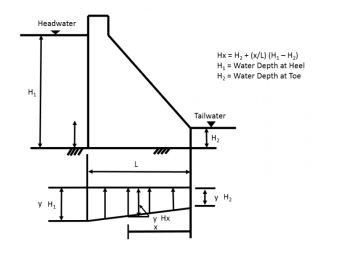Linear vs. Non-linear

|
| Learn more about the need to consider uplift pressure when designing a gravity structure at DamFailures.org |
"Both new and existing structures are constantly being examined to determine if they meet stability criteria. The traditional procedure is to evaluate sliding stability of these structures using the limit equilibrium method of analysis and to evaluate rotational stability using rigid body assumptions and bearing pressure distributions that vary linearly across the base. Soil and uplift loads on the structure are often based on simplifying assumptions. In the limit equilibrium method, only the stress at failure is considered, usually as represented by the Mohr-Coulomb limit-state criterion. The simplified loads and the Mohr-Coulomb limit-state criterion are then used to obtain a single overall factor of safety against a sliding stability failure. This traditional approach is appropriate for many structures where it is difficult to predict just how a particular failure mechanism may develop. However, for existing structures where more is known about service state conditions and uplift pressures, it is possible to more precisely predict what stress changes must occur to develop a failure condition. The margin of safety can be more accurately determined when the path to failure, from initial stress conditions to limit state conditions, is known. This path to failure can be investigated using linear elastic and nonlinear finite-element numerical solutions and facture mechanics concepts. Because the deformation of the structure and its foundation is considered in finite element analyses, and because the path to failure can be more realistically characterized through facture mechanics, a more accurate assessment of safety can often be made using advanced analytical methods."[1]
Best Practices Resources
![]() Stability Analysis of Concrete Structures (EM 1110-2-2100), USACE
Stability Analysis of Concrete Structures (EM 1110-2-2100), USACE
![]() Gravity Dam Design (EM 1110-2-2200), USACE
Gravity Dam Design (EM 1110-2-2200), USACE
![]() Arch Dam Design (EM 1110-2-2201), USACE
Arch Dam Design (EM 1110-2-2201), USACE
![]() Sliding Stability for Concrete Structures (ETL 1110-2-256), USACE
Sliding Stability for Concrete Structures (ETL 1110-2-256), USACE
Trainings
![]() On-Demand Webinar: Stability Evaluations of Concrete Dams
On-Demand Webinar: Stability Evaluations of Concrete Dams
![]() On-Demand Webinar: Analysis of Concrete Arch Dams
On-Demand Webinar: Analysis of Concrete Arch Dams
Citations:
Revision ID: 7164
Revision Date: 07/11/2023
